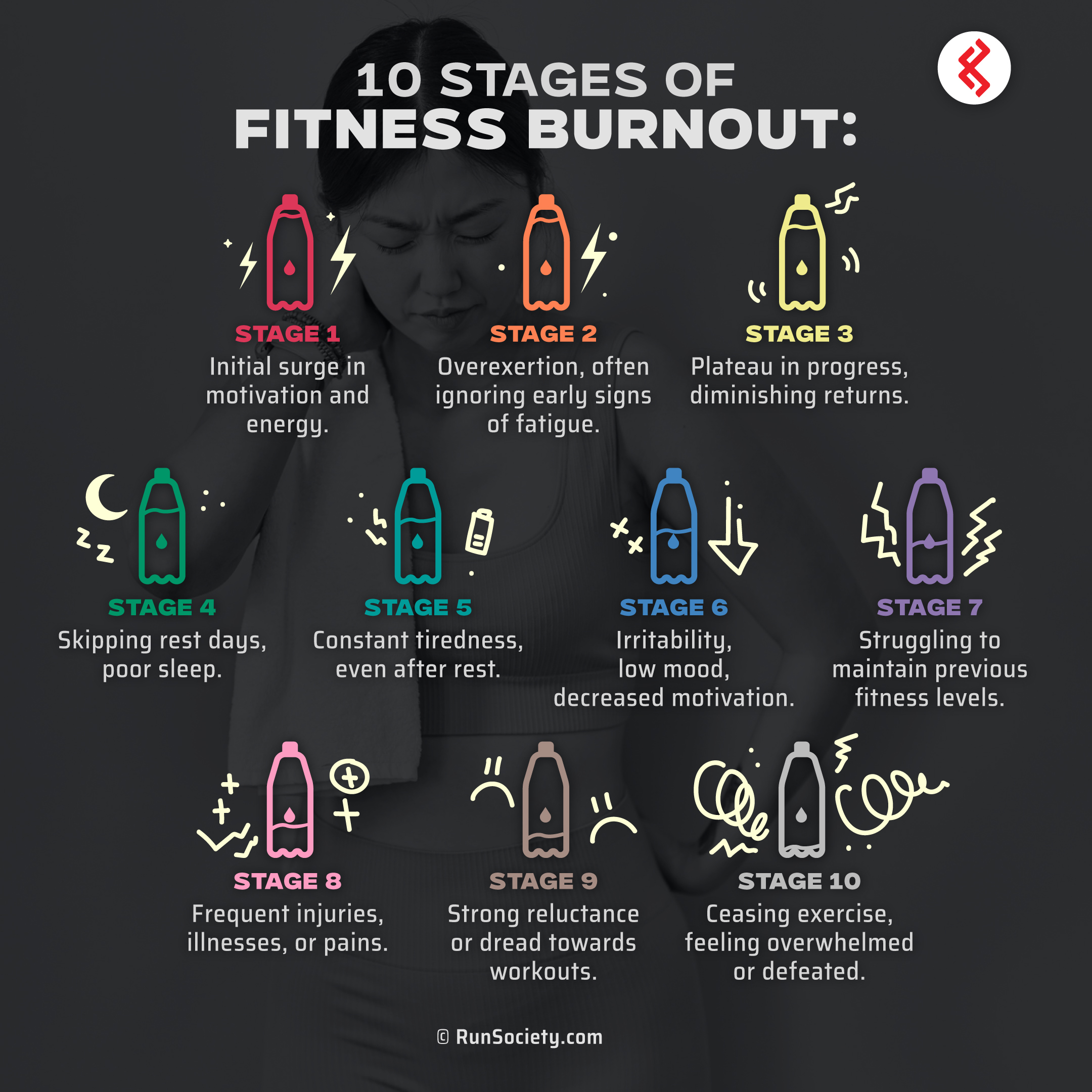Today, health and aesthetics drive many to push their physical limits, it’s not uncommon to see individuals aiming for the pinnacle. However, while such determination can lead to impressive accomplishments, it can also precipitate a phenomenon termed ‘fitness burnout.’
In this piece, we explore the ten stages of fitness burnout, revealing the scientific reasons behind each and offering remedies to mitigate their effects.
In this Article
What is Fitness Burnout?
Fitness burnout, often referred to in medical literature as “overtraining syndrome” or “chronic fatigue syndrome in athletes,” is a state of physical and emotional exhaustion related specifically to physical activity. This condition doesn’t just affect elite athletes; it can impact anyone who is intensely involved in exercise or sports activities.
The British Journal of Sports Medicine defines overtraining syndrome as “a condition characterised by a collection of emotional, behavioural, and physical symptoms due to overtraining that has persisted for weeks to months.”
Symptoms often include mood disturbances, reduced performance, and physiological changes that are detrimental to the health of the individual.
In a study conducted on Canadian athletes training for the Olympics, it was found that 42% of athletes met the criteria for one or more mental disorders.
Additionally, the American College of Sports Medicine reports that around 35% of elite athletes suffer from disordered eating, burnout, depression, and/or anxiety. The reasons for this are multifaceted, from excessive physical training without adequate rest to the pressures of maintaining performance levels.
Burnout can affect both the body and the mind. Physically, the body struggles to recover, muscles become more susceptible to injury, and immunity can weaken. Mentally, it can lead to a lack of interest in exercise, decreased motivation, and feelings of dread about workouts.
It’s essential to recognise the early signs of fitness burnout and address them promptly. Pushing through without addressing the root causes can lead to more serious health implications and prolong recovery times
Identifying the 10 Stages of Fitness Burnout

Looking to visualise your ideas effectively? Explore creative infographic designs with this top design agency.
Stage 1: Eagerness
- Description: It all begins here, with an initial surge of motivation, often ignited by a personal ambition or an external event.
- Medical Fact: Dopamine, a neurotransmitter associated with pleasure and motivation, surges during the onset of a new fitness routine.
- Remedy: Harness this enthusiasm, but set achievable goals and take things at a steady pace.
Stage 2: Pushing Harder
- Description: The urge to witness results can result in overexertion, frequently sidelining early fatigue signs.
- Medical Fact: Overtraining can cause a disruption in the body’s cortisol levels, elevating stress.
- Remedy: Heed your body’s signals. Introduce variety in your routine to prevent straining specific muscle groups.
Stage 3 Stagnation
- Description: Despite rigorous efforts, one hits a plateau.
- Medical Fact: The body becomes accustomed to repeated stress, diminishing the efficacy of a consistent routine.
- Remedy: Refresh your fitness routine every 4-6 weeks and integrate cross-training.
Stage 4: Neglecting Recovery
- Description: Prioritising workouts over rest leads to inadequate sleep and recovery.
- Medical Fact: Between workouts, the body rejuvenates and fortifies itself.
- Remedy: Ensure ample rest days and emphasise quality sleep.
Stage 5: Chronic Fatigue
- Description: Persistent tiredness lingers, even with enough rest.
- Medical Fact: Overexertion can result in adrenal fatigue, where the adrenal glands struggle to produce essential hormones.
- Remedy: Reduce workout intensity and concentrate on a balanced diet.
Stage 6: Mood Fluctuations
- Description: Escalated irritability, a dip in mood, and dwindling motivation.
- Medical Fact: Excessive physical activity can influence serotonin levels, pivotal for mood regulation.
- Remedy: Employ relaxation strategies such as meditation and deep-breathing exercises.
Stage 7: Decreased Performance
- Description: Difficulties arise in sustaining prior fitness levels.
- Medical Fact: Prolonged overexertion can lead to muscle degradation rather than development.
- Remedy: Incorporate active recovery sessions, like gentle yoga or swimming.
Stage 8: Physical Symptoms
- Description: The emergence of regular injuries, ailments, or inexplicable aches.
- Medical Fact: Overtraining weakens the immune system, making one more susceptible to infections.
- Remedy: Seek medical counsel and consider a comprehensive break if symptoms persist.
Stage 9: Aversion
- Description: A mounting sense of trepidation or resistance towards training sessions.
- Medical Fact: Chronic stress can cause hormonal imbalances, reducing the pleasure derived from previously enjoyable activities.
- Remedy: Reassess your objectives and discover new activities that rekindle your enthusiasm.
Stage 10: Withdrawal
- Description: A sensation of being swamped, culminating in discontinuing exercise.
- Medical Fact: Sustained periods of elevated cortisol can result in both mental and physical exhaustion.
- Remedy: It might be prudent to seek professional counselling or therapy. Mental well-being is pivotal in the fitness journey.
Note: It’s important to understand that these stages don’t always occur in a linear fashion. Some may skip stages or experience them in a different order. Recognising the signs early and seeking support can help mitigate the depth of burnout.
Striking the Balance: Sustainable Fitness for Lifelong Well-being
Identifying the signs of fitness burnout is paramount for enduring success. Whilst dedication and perseverance are praiseworthy, it’s equally vital to be attuned to one’s body and mind, ensuring that the path to fitness is sustainable and pleasurable.
Remember, fitness is a marathon, not a sprint.
Recognising where you stand is the first stride towards a healthier, balanced lifestyle. This guide not only helps you identify your current stage but also offers tips to reignite your fitness passion and prevent future burnout.
With personalised insights, navigate through the maze of fitness burnout, reclaim your vigor, and restore the equilibrium between your body and mind.
Share this infographic to spread awareness on fitness burnout, help others pinpoint their burnout stage, and foster a community empowered to regain control over their well-being.





